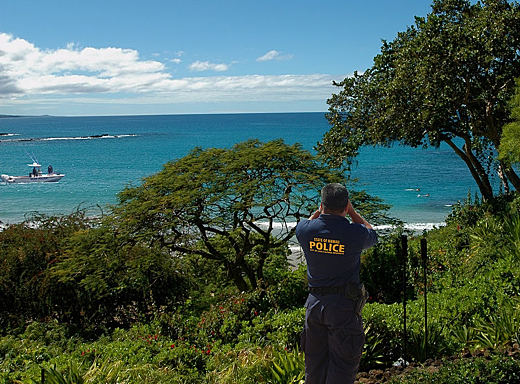By Joan Conrow on 19 January 2012 for Kauai Eclectic -
(http://kauaieclectic.blogspot.com/2012/01/musings-truly-new-day.html)

Image above: DLNR armed uniformed police patrol on land and in the ocean. From (http://en.wikipedia.org/wiki/Hawaii_Division_of_Conservation_and_Resource_Enforcement).
Driving to the beach for sunrise, I'm starstruck not by the stars, which were disappearing, but all the mountains — Kalalea, Makaleha, Waialeale, Kawaikini — standing perfectly clear against a backdrop the color of pink ginger. At the shore, the drama continues, with a strategically placed cloud blocking the top half of a fiery red sun, causing five broad shafts of rose and silver light to beam from sea to sky. The water, smoothed by a faint offshore wind that carries the musky-sweet scent of white hinano hanging in coastal hala trees, is a color somewhere between blue and brown, and conditions are perfect for the guys who pulled into the parking lot right behind me, driving a truck with a window decal of a diver preparing to spear a tako.
I think of the conversation I had the day before with fisherman/surfer Greg Holzman, who expressed concern about the possible loss of shoreline and ocean access that he and others fear could accompany critical habitat designations for the monk seal and the creation of marine life sanctuaries. I think also of comments he made about how access to the island's mauka areas has been lost with the closing of sugar plantations, development, landowner worries about liability.
As a result, he said, the areas that are open, like Kokee, get overused, creating conflicts between hunters and hikers/tourists, and the pig population has exploded in the places where guys can't get in to hunt anymore. And that makes me think of DLNR's new plan to protect our watersheds — provided the Legislature kicks down $11 million per year. Perhaps that's why the agency is taking its case to the public in the opening days of the Lege with a television special, “The Rain Follows the Forest,” set to air on KGMB at 6:30 tonight, and again at 4:30 p.m. on Sunday. The plan, which is part of Abercrombie's “New day in Hawaii,” and so includes language about public-private partnerships, sounds a serious alarm:
Immediate action is needed to secure Hawaii’s water supply. Hotter, drier conditions and damaged watersheds are escalating the costs and conflicts over water. Fresh, clean water is an irreplaceable resource. It is fundamental to our well-being. It fuels agriculture, tourism, and sustainable development. In turn, our water supply depends on the health of our mauka native forests, which capture and absorb rain. With over half of the original forest lost, and the remainder threatened by exploding populations of invasive species, the forest now relies on us for its survival.The proposal identifies fencing key watersheds and removing all hooved animals from those enclosures as “the first step towards protection” — a concept that is essentially a repeat of what plantation owners did in the early 1900s. But it's likely to meet strong resistance from hunters, who have long had tremendous influence on public land management in Hawaii.
Though the plan calls for using hunters to remove the animals wherever it's safe to do so, hunters have consistently opposed efforts to fence public lands. When the state talks about partnerships, perhaps it could push harder for improved mauka and makai access, so that people, especially those who secure food through hunting and fishing, don't continue to feel so squeezed, which feeds conflicts with other humans, as well as wildlife. Witness the recent attacks on the monk seals, which are viewed as fishing competitors. I was also interested in the proposal's acknowledgement that:
Additionally, resorts are the most water-intensive land use, using over three times more water per acre than industrial and commercial, and five times more water per acre than agriculture. Because of this, water-intensive resort development and expansion can be restricted by limited water supplies.But mightn't that be a good thing? Especially since the proposal also recognizes:
[T]he unique cultural and natural resources that attract visitors to Hawai`i are declining. Native species sacred to the Hawaiian culture are disappearing at the highest extinction rate in the nation because of development, introductions of invasive species, and other threats.Once again we're confronted with this ongoing disconnect between conservation and development. We keep acting like we can have both, and we keep getting knocked up side the head by proof that we can't. If we're going to spend millions to protect the native forests, why not also get sensible about determining the carrying capacity of these islands when it comes to tourism? We've already heard Richard Lim, director of the state Department of Economic Development and Tourism admit:
[T]ourism has essentially remained stagnant for the last 20 years and can no longer be relied on to move the economy into a prosperous future.So why keep pretending like it will? Instead of spending money to lure more and more tourists to the Islands, and jumping through hoops to ensure they're entertained, why not channel a big chunk of dough into supporting local ag? That way we'd save water, increase our self-sufficiency and keep our hard-earned cash in Hawaii, rather than sending it out to the places that grow our imported food. It's good to see DLNR pushing its ambitious plan to protect watersheds, and hopefully it's not too late.
But if the Guv truly wants to usher in "a new day in Hawaii," he needs to start steering the Islands away from their dependence on tourism and the military, neither of which will ever be sustainable, and into practices that are.
See also:
Ea O Ka Aina: A Truly Old Day 1/20/12
.
No comments :
Post a Comment